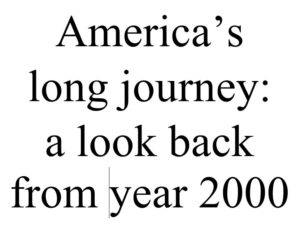
Shay’s rebellion
As usual, the deck was stacked. The poor and dispossessed had no way to obtain justice save organized resistance to the institutions oppressing them. That resistance evoked the predictable counter-reaction among the rich and powerful decrying “mob rule.” Financial power financed physical might, which, as usual, prevailed. But, in the tangled way that history sometimes works, Shay’s Rebellion may have helped the American experiment in republican government to succeed by showing the weakness of the Confederation government.
It was 1785. The Revolutionary War was over – had been over for two years – but its economic consequences continued to accumulate. Massachusetts merchants were being squeezed by their European trading partners, who had been glad to extend credit to them while they were British, but now would sell only for hard money – that is, gold or silver: specie. The merchants, in turn, began demanding specie from their local business partners, who of course then made the same demand of their customers. But coins were in short supply.
That was bad enough in the coastal areas, which lived by trade with the other colonies, with the West Indies, with Europe. Even in bad times, cash was the norm. But towns in the state’s central and western regions saw little cash even in good times; they often bartered for goods or services, or obtained goods on credit and repaid when crops were in. When a subsistence economy suddenly is required to conform to the norms of a market economy – well, it can’t. People started losing their land to foreclosure for commercial debt, and for taxes. Adding insult to injury – or perhaps we should say, adding insult and injury to injury – many of these hard-pressed inhabitants were veterans of the war who were owed back pay and couldn’t get it.
Daniel Shays was one of these former soldiers. He and others began organizing protests such as had already occurred in 1782 and 1783. After those earlier protests, the people had requested that the state legislature issue paper money, but the legislature was dominated by the very merchants who were the lenders. The last thing they were going to do was risk currency inflation that would dilute the value of the money they were owed.
In 1785, merchant James Bowdoin was elected governor. He stepped up civil actions to collect back taxes, and the legislature made matters worse by levying an additional property tax to raise funds for the state’s portion of foreign debt. In the summer of 1786, the legislature adjourned without considering any of the petitions from the rural populace. Should it have been a surprise when people took to direct action?
In August, protestors prevented a county court from sitting, trying to halt the foreclosure process. Other states had faced similar protests, and had solved it, as usual, by calling out the militia. (It is worth noting that in Rhode Island, what was called the “country party” gained control of the legislature in 1786 and forced merchants to trade debt instruments for devalued currency, which resolved the problem. Not Massachusetts.) But when Governor Bowdoin did call out the county militia, after another court had been shut down by organized protest, he found that the men were in sympathy with the protestors, and refused to turn out.
In September and October, three more community protests shut down their courts, and courts in the larger towns and cities were able to meet only under militia protection. The legislature finally did make some concessions, allowing certain old taxes to be paid in goods rather than cash, but then it added measures prohibiting speech critical of the government. It offered pardons to protestors willing to take an oath of allegiance, but the protests continued.
In September, an armed confrontation between protestors led by Shays and Luke Day had been resolved without violence. In November, a posse arrested Job Shattuck and other protest leaders in the eastern part of the state. Protestors in western Massachusetts took note, and began to prepare not only to resist, but to overthrow the state government.
The Confederation government was broke as usual, and had no money for troops. So in January, 1787, the Massachusetts merchants created a privately funded militia of 3,000 men, which marched westward. The rebels established regional regimental organizations, and targeted the federal armory in Springfield. After a brief battle, the rebels were chased north and scattered, many escaping into New Hampshire and Vermont, which refused to yield them up to Massachusetts authorities.
The only measures the state legislature took were designed to deal with the act, not the causes, of rebellion. It passed bills authorizing martial law, and the recruitment of additional militia, and state payments to reimburse merchants for funding their private army. It passed the Disqualification Act, forbidding acknowledged rebels from holding certain elected and appointed offices. After government control was reestablished, most of the rebels were pardoned under a general amnesty. Of 18 leaders convicted and sentenced to death, all but two were freed. Two were hanged.
But Governor Bowdoin lost the gubernatorial election of April 1787. Governor John Hancock and the newly elected legislature cut taxes, placed a moratorium on debts, and Massachusetts securities fell by 30% as interest payments fell into arrears. (This was of course regarded by the merchant class as a far greater calamity than people losing their farms to foreclosure.)
But more to the point – perhaps the second-greatest good derived from the doomed rebellion, after the defeat of Bowdoin and his legislature – was the effect on statesmen throughout the 13 former colonies. The lesson they took away was not that economic oppression leads to desperation, but that the Confederation government was too weak to sustain itself. Ironically, Shay’s rebellion strengthened the Federalists in the convention that would shortly meet in Philadelphia.